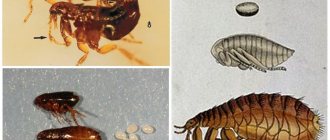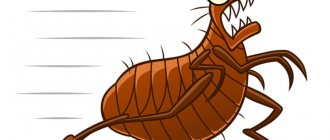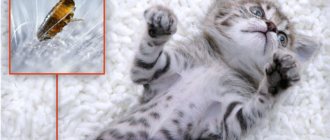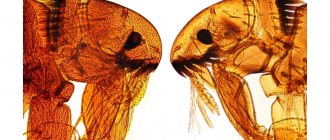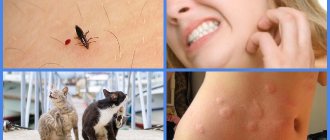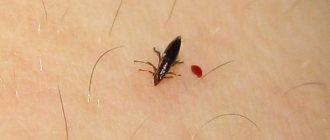Home >> Insects
Fleas belong to the order of blood-sucking insects with complete metamorphosis, which are often carriers of various pathogens of human and animal diseases. Fleas are secondarily wingless. They completely lost their wings in the process of adapting to ectoparasitism in the imaginal phase. Fleas have highly specialized oral apparatus designed to pierce the host's integument and suck blood. Currently, scientists have described 2086 species, including 4 fossil species (Zhang, 2013)[1]. The order includes more than 200 genera, grouped into 15 families[2]. The family of common fleas (Pulicidae) includes species of economic and medical importance: Pulex irritans, Ctenocephalides felis, Ctenocephalides canis, Spilopsyllus cuniculi, Xenopsylla cheopis are fleas of humans, cats, dogs, rabbits and rats, respectively. The British Museum has a collection of fleas from the British banker and entomologist Charles Rothschild.
Here it is, this modern monster:
The body of fleas is laterally compressed, narrow, smooth, equipped with bristles and spines that help them move and stay in the thick fur and between the feathers of their hosts, in the folds of clothing, as well as in the substrate of their nests and burrows. The head and chest often have serrated ridges (ctenidia). The body length varies from 1 to 5 mm in different species, but in females of some species it can reach 10 mm due to the hypertrophic growth of the abdomen after the start of feeding. The antennae are always located behind the simple eyes and, at rest, are placed in special recesses - antennal fossae. The antennae may be used by males to hold the female during copulation. The oral apparatus of fleas is of the piercing-sucking type. It is characterized by the transformation of epipharynges (unpaired stylet) and lacinia (paired stylets) into stylets, articulated with the maxillary lobes. The lower lip with a pair of labial palps is transformed into case flaps for the components of the proboscis. The mandibles in adult fleas are completely lost. The chest is equipped with strong limbs, providing the insect with rapid movement in the host's integument and the ability to stay on rough surfaces at any angle. They often move by jumping, using the second and especially the third pair of legs to push. In the posterior part of the abdomen, behind tergite VIII, there is a unique sensory organ found only in fleas - the abdominal sensillium, or pygidium, equipped with trichobothria (tactile hairs) and capable of detecting air vibrations.
Origin of the species and description
Photo: Flea
Fleas form a small group of insects that are probably descended from the ancestor Mecoptera (scorpions), with which they share certain characteristics. Both groups have a spinous stomach, sex differences in the number of ganglia in the ventral nerve canal, six rectal glands, and a simple ovary type.
Males have a similar type of sperm, unique to the arthropod phylum, in which a motile flagellum or tail, lacking an outer ring of nine tubules, is located around mitochondria (cellular organelles). Fossil fleas discovered in Australia are said to be 200 million years old. Two other known fossil fleas come from Baltic amber (Oligocene) and are very similar to "modern" fleas.
Video: Flea
Because fleas are capable of jumping horizontal or vertical distances up to 200 times their body length and achieving accelerations of 200 g, they have been described as insects that fly with their feet. Some species that live in nests high above the ground or in other unusual habitats crawl rather than jump.
Fun Fact: Occasional uses of fleas' unusual strength occur in "flea circuses" in which they pull miniature carts and perform other feats.
Fact #10
Even royalty suffered from parasite bites.
King Louis XIV of France ordered the establishment of a special position at court - a page for catching fleas.
The page's skills were used during royal dinners at the Palace of Versailles and the Louvre.
It’s simply wonderful that in the modern world they take a very responsible approach to regulating the number of domestic insects, including fleas. After all, as history shows, the problem of the spread of parasites left to chance can affect the fate of states.
The flea is a blood-sucking insect that is an important vector of disease and can be a serious pest. Fleas are parasites that live on the outside of the host (i.e. they are ectoparasites). As the main agent of the Black Death (bubonic plague) in the Middle Ages, they were an important link in the chain of events that led to the death of a quarter of Europe's population.
Appearance and features
Photo: What a flea looks like
Fleas are small, wingless insects with tough cuticles that have many bristles and frequently combed, broad, flattened spines. Adult fleas range in size from about 0.1 to 1 cm in length. About 2,000 species and subspecies of fleas are known, but this order is still small compared to many other groups of insects. However, it is widespread among some, such as the rat flea and mouse flea, which are carried by people around the world.
Anatomically, adult fleas are a fairly homogeneous but distinctive group, with many interesting modifications and few obvious connections to other species. The compressed body allows them to move quickly along the hair or feathers of the host, while the spines or ridges projecting back serve to anchor them within the fur, hair or feathers.
Their mouths are modified for sucking blood and include barbed spines that aid in both the penetration of fleas into the host's skin and the attachment of species that spend long periods attached to the host (such as sticky fleas). Typically, fleas that live on diurnal hosts have well-developed eyes, whereas species that parasitize underground hosts (such as moles) or nocturnal animals (such as bats) have poorly developed eyes or no eyes at all.
Interesting fact: The most impressive adaptations of fleas are their highly developed jumping legs. During their evolution, fleas, like most parasitic insects, lost their wings. However, some parts of the flight mechanism were retained and incorporated into the jump mechanism.
On flying insects, a rubbery protein known as resilin forms the hinge that attaches the wings to the body. Resilin absorbs the compression and tension created during each wing strike, and the stored energy is transferred through an elastic recoil effect to help initiate each subsequent strike.
The fleas, despite their wingless state, retained elasticity on the thorax where the legs are attached to the body. When the flea squats, the elastic pads are compressed and it is maintained in this state by a muscle-controlled gripping mechanism. In the moment preceding the jump, the holding muscles relax and the energy in the rubber pads is transferred through the legs. This creates a lever effect that pushes each shin and leg to the ground and thereby causes the flea to jump.
A flea under a microscope: what the parasite looks like
The structure of all types of fleas is similar:
- fleas have a small flat body. Initially, the parasites had wings, but over time they disappeared as unnecessary. This is due to the fact that animals have thick fur, from which it is impossible to take off;
- The flea's hind legs are long - if they are stretched out, they will be larger than the entire body of the parasite. A flea's jump is similar to the action of a spring. In a calm state, the parasite folds its legs, and in case of danger, they, like a spring, sharply straighten, allowing the parasite to “fly out” at a distance of up to 1 meter;
- There are air cavities in the hind legs of the parasite. During a jump, the parasite directs air there to provide shock absorption upon landing;
- The flea has a high reaction rate to danger due to the presence of special organs on the abdomen. Ctenidia in fleas detect the slightest vibrations in the air.
All parasites are divided into several types:
- insects that parasitize warm-blooded animals (dogs, cats, gopher flea, etc.);
- bird fleas (chicken, pigeon fleas);
- insects that parasitize humans.
All parasites have the same body structure. The size of the flea is 3-5 mm, the body is flattened and brown in color. The body consists of three sections - head, abdomen, thoracic compartment.
Fleas feed on blood, biting the owner and injecting a poisonous secretion into the blood. In general, parasites can feed on any blood, but prefer their own type of animal.
What do flea eggs look like?
These are small light ovals that are invisible at first glance. The problem is that fleas do not lay eggs on the host - to do this, they find a remote, safe place (textiles in the house, a recess behind the baseboard).
What do flea larvae look like?
These are small light-colored worms that do not live on the host. They can be located in the animal's bedding or hidden in the carpet. You can get rid of larvae by treating things with high or low temperatures.
Where does the flea live?
Photo: Cat flea
Native flea species are found in polar, temperate and tropical regions. Fleas, especially Xenopsylla cheopis, are considered the main carriers of murine (endemic) typhus, a rickettsial disease of humans. The source of infection are rats and mice. Fleas are considered important for the maintenance and spread of many locally limited infections among rodents and other mammals, including tularemia and Russian spring-summer encephalitis.
Fleas transmit myxomatosis, a viral disease of rabbits, which is used deliberately to control rabbits in areas where they are a serious pest (eg Australia). Fleas are likely carriers of canine filarial worms and serve as intermediate hosts for the common tapeworm (Dipylidium caninum) in dogs and cats and sometimes children. If the infestation is severe, animals may be seriously injured or killed by flea bites and may lose blood as a result. Fleas are susceptible to parasitism from external mites, internal nematode worms, as well as bacterial, fungal and protozoan infections.
The female piercing flea burrows into the skin of its host, usually on the legs, and lives in a cyst that forms around it. Severe itching accompanies the development and expansion of the cyst, as the belly of a pregnant flea grows to the size of a pea; secondary infections can present serious complications.
Now you know where fleas are found and how to deal with them. Let's see what they eat.
What does a flea eat?
Photo: Flea on an animal
Fleas feed exclusively on the blood of mammals (including humans), as well as birds. A flea infestation can lead to severe skin inflammation and severe itching. Although many animals acquire partial immunity after persistent or repeated attacks, individuals (especially humans) can sometimes become sensitized after exposure and develop allergies.
Species that attack people and livestock include:
- cat flea (Ctenocephalides felis);
- the so-called human flea (Pulex irritans);
- dog flea (Ctenocephalides canis);
- sticky flea (Echidnophaga gallinacea);
- penetrating flea (Tunga penetrans);
- European chicken flea (Ceratophyllus gallinae), which can parasitize poultry;
- western chicken flea (Ceratophyllus niger) in the United States.
Some fleas, which feed primarily on rodents or birds, sometimes attack people, especially when their usual host is not present. When rats die from bubonic plague, their hungry fleas, themselves infected with the plague bacilli and seeking food elsewhere, can transmit the disease to people, especially in buildings heavily infested with rats.
The eastern rat flea (Xenopsylla cheopis) is the most effective carrier of plague, but other flea species (eg, Nosopsyllus flaviatus, Xenopsylla brasiliensis, Pulex allerans) can also transmit the disease to humans. Although there are cases of plague in tropical and some temperate regions, the disease in humans can be controlled with early diagnosis and antibiotics.
Interesting Fact: Plague (sylvatic plague) is a widespread disease among hundreds of species of wild rodents around the world, which is maintained in these populations by fleas that parasitize these animals. It is known that more than 100 species of fleas can be infected with the plague bacillus, and another 10 species are carriers of the classic type of urban plague.
Features of character and lifestyle
Photo: Flea insect
Some fleas (such as rabbit fleas) are very host specific, while other species parasitize a variety of mammals. The cat flea infects not only the domestic cat, but also dogs, foxes, mongooses, possums, leopards and other mammals, including humans, if its normal hosts are not available.
Related mammals tend to parasitize fleas, which are themselves related. Thus, peak rabbits (Ochotona) living in the rocky mountains are infested with two distinctive genera of fleas that are also found on peaks in the mountains of Asia, indicating a close phylogenetic relationship between these geographically separated hosts. Bird fleas have relatively recently adapted to their hosts. They share several similarities, one of the most obvious of which is the increase in the number of ridges on the upper surface of the thorax, which serve to anchor them within the feathers.
Interesting fact: Monkeys do not eat fleas, nor do horses and most ungulates. The most parasitic group of mammals are rodents. Their habit of building nests in burrows promotes the development of flea larvae. Animals without permanent residence tend to carry fewer fleas.
Although both flea sexes feed voraciously and repeatedly on blood, they survive for varying periods of time, regardless of the host. For example, a rabbit flea can survive nine months at temperatures near freezing without feeding.
Fact #8
Small insects, causing great inconvenience, set the direction for the development of the fashion industry in the Middle Ages.
The ladies of the court, who did not undo their complex hairstyles for months and did not bother with bathing procedures, seriously suffered from bites of harmful fleas. As, indeed, are the gentlemen.
It was then that ladies began to attach small trained dogs under their lush crinolines to catch fleas. And the bitten scalp was scratched with special long knitting needles.
Fur boas, collars, and medallions with a hole in which a sticky substance was poured in to attract insects served as bait for fleas.
A little later, silk underwear appeared in the ladies' arsenal, along which fleas slid without stopping.
In case of insect bites, you should act immediately. Read more about how to help with insect bites of different types in this article.
Sometimes bedbugs need to be dealt with using radical methods. You will find useful information on this topic at https://stopvreditel.ru/doma/sredstva/kerosina-i-spirt-protiv-klopov.html link.
Social structure and reproduction
Photo: Little flea
Life cycle details are available for only a few flea species. They have four life stages - egg, larva, pupa and adult. Pearly white, oval eggs are laid on the body, nest, or habitat of the host animal.
The larva is small and legless and feeds on organic debris such as dried excrement, dried pieces of skin, dead mites or dried blood found in the host's nest. Adult fleas quickly pass freshly absorbed blood through the intestines to produce feces to feed their babies, which is necessary for the successful metamorphosis of some species of flea larvae.
After three (in rare cases two) molts, the larva unwinds a silk cocoon, which includes debris from the nest and enters the pupal stage. The pupa develops into an adult after a few days or months. Some species may enter a developmental arrest at the end of the pupal stage and will not become adults until a host emerges. Depending on the species or environmental conditions, the time required for a flea to complete its life cycle varies from two weeks to several months.
Interesting fact: The lifespan of an adult flea ranges from a few weeks (for example, Echidnophaga gallinacea) to a year or more (Pulex allerans).
The life cycle of the European rabbit flea (Spilopsyllus cuniculi) and its host are perfectly synchronized. Sexual development of male and female fleas is directly controlled by the rabbit's sex hormones. Thus, the eggs of a female flea only mature successfully if she feeds on a pregnant rabbit.
When young rabbits are born, both sexes of fleas mature and leave a mother for the chicks and a nest where they copulate and lay eggs, thus providing the flea larvae with a suitable habitat for development. If the female rabbit's sex hormones are artificially controlled by the administration of a synthetic progestin (contraceptives), the female flea's sexual development is also stopped.
Although a similar case among other flea species is not yet known, it has been documented that rat fleas are less fertile when fed on infant mice than on their parents, and that the mouse flea (Leptopsylla segnis) is more fertile when reared in larger family units. than in individual adult mice. It is therefore likely that the influence of host hormones is more widespread than expected.
Natural enemies of fleas
Photo: What a flea looks like
The enemies of fleas are people who try in every possible way to get rid of them. When controlling fleas, it is best to treat both the host's nest, or area of litter that is the breeding ground for fleas, and the infested host at the same time, since the larval and pupal stages usually develop away from the host's body.
For infested animals, a commercial dust, spray, or aerosol containing an insecticide or growth regulator is used. However, in some regions, fleas have become resistant to some insecticides and new materials are required. To control larval and adult fleas away from the host, insecticides or growth regulators can be applied to the pens and shelters of affected animals. Repellents can be effective in preventing flea attacks.
The flea life cycle is interrupted when the temperature drops below 21 degrees Celsius or there is an excessive drop in humidity. Thus, thoroughly cold washing bedding or leaving items outside during freezing temperatures can help control potential flea infestations while other measures are in place.
Preventative measures can help avoid rashes and irritation for pets. It's easier to prevent fleas than to get rid of an infestation. It can take up to 6 months to completely remove fleas, as different stages of the flea life cycle can persist in various hidden areas of the home and pets, avoiding reaching a vacuum or other physical and chemical measures to kill them.
Flea Behavior and Identification
Fleas are quite active and sense the approach of danger very well thanks to sensory organs that detect the slightest shudders in the air. This is why it is almost impossible to neutralize a flea with bare hands .
There is a high probability that it will move to another owner and continue to be saturated with his blood. We should also not forget that most fleas are not on the animal itself, but in its environment, which complicates the process of pest control.
When purchasing a drug to exterminate parasites from a pet pharmacy, do not forget to inquire about their toxicity level for the animal and check the period of its action.
As you know, it is easier to prevent than to cure. Special animal collars that are impregnated with insecticides will help you with this.
